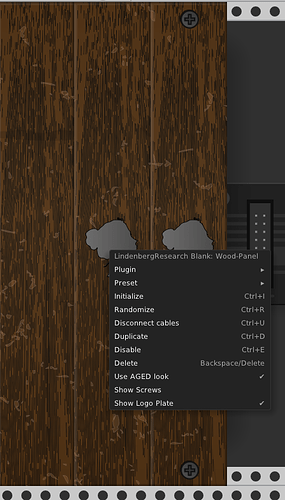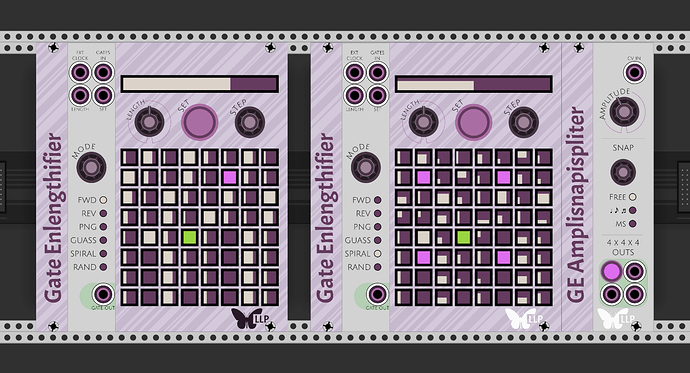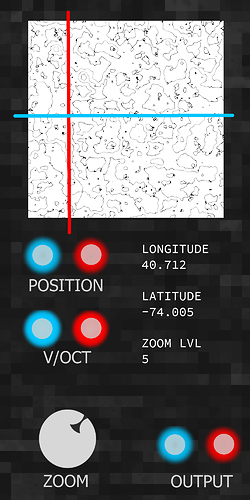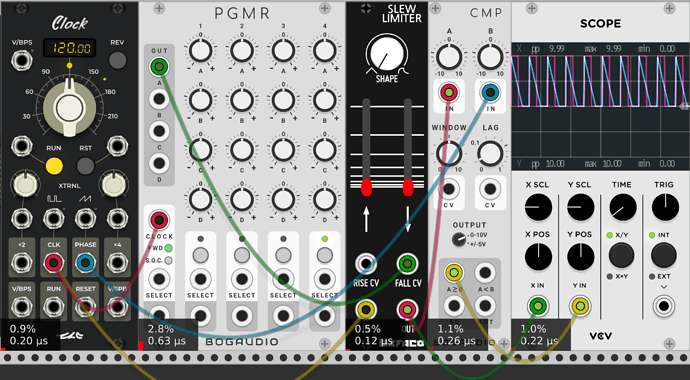There are options ![]()
xD thanks.
I’m feeling the need for a stereo sequential switch. Basically doing what the ML 8 to 1 does, but with stereo in and out, and a random trigger. This would be incredibly useful, since I tend to use a lot of sounds and switch between them randomly. Not sure how to do that with stereo signals though, at least not in a random way. Using two doesn’t work, because it won’t do the same random order on both, and it’ll be two different mono signals. Maybe there’s one in the 2k modules we have, but I haven’t found any yet.
Features: 8 stereo in (at least) L/R out Up/down/random trigger inputs Step CV input Reset input Option to adjust number of steps, with CV input.
Something like that? I’m just stealing an idea that works. 
Aren’t the modules from ML polyphonic? Wouldn’t a polyphonic switch satisfy your request?
I’m not sure how to translate that to stereo audio though. It’s not quite the same from what I can tell.
Stereo audio is just two channels in a polyphonic cable.
You could use two voltage addressed switches supplied with the same random voltage
There’s actually a Lindenberg module that makes this more convenient:
It would be interesting to feed GPT-3 with all the different discussions here and in the FB group so it could then respond to questions of the, “Are there any modules that _____?” or “How do you _____ ?” varieties. And hey! You could have it give its answer in freestyle rap!
It works, but it’s a cumbersome workaraound for something that could have been intuitive and simple. It would be nice to have a dedicated tool, since so many sources are stereo. Gonna have to stack a lot of those modules.
But thanks for the tip anyway. It’ll have to do for now.
I needed to mock something up in order to organize my thoughts so:
Gate Enlengthifier A sequencer for gate lengths. It takes gates or triggers in and changes the length according to a range from 1/32x to 4x of an external clock cycle, or also 0 in which case the gate is skipped for a 1/4 of a clock cycle. Turning the step knob moves the green cursor through the sequencer linearly with the current step being displayed above the knobs. The length knob changes the length that the step will assign, and the set button saves the setting for the step. The purple “play” cursor moves according to the mode selected using the mode knob. There are four inputs and one out.
The inputs are an external clock that sets size of the cycle length for the modifier, an external gates source to modify, a cv for the length control, and another trigger-in to press the set button with cv. The output is the modified gates.
Topographic Synth
Inspired from Geological Phonograph I think a topographic map to synth could be pretty cool. I actually have at least started on this but am having a heck of a time finding a good source of data that’s reasonable. https://viewer.nationalmap.gov/basic/ (1 meter DEM) works, but the files are ~500Mb which is clearly not ideal. The other option would be to generate fake topographic maps or just allow the arbitrary use of .png files- regardless, I was thinking something like this:
note, this is a quick mock up panel. I know it’s ugly. Also, yes, this is just a ‘fake’ map generated from noise.
So, if you think about this as a 3d map, you’d take a slice out of the map in each of X and Y, then the Z (height) is your amplitude in each slice, giving us two waves from the same 3D wavetable. Then, the V/oct inputs would be the scan speed of said waves (of course, we wouldn’t know the base pitch of any given area, but the hope would be because the wavefrom is complex enough that we could simply have V/oct drive an internal osc at that pitch to scan over the waveform. Otherwise, the V/Oct inputs could also just be like X’ and Y’ inputs, to indicate position in the wave with a phase driven input), finally, outputs for both the X and Y audio. Other controls may be necessary too, such as in noralization knob, to make flatter areas still make sound and make mountainous areas not too loud.
Anyway, I don’t actually think I have time to really go all out on this, and I never really got anything useful with code, so if someone else can take over the idea I still think it could be really cool.
Edit: I also realize one way to handle lookup would be to make this internet connected and use an api to some service. I think that this would be not-great. My preference at least would be to just allow people to load the files in rack with a right click menu. If an api is used, I do think caching would be good at the very least to avoid VCV rack users hug-of-deathing someone. ![]()
So, this is pretty much exactly something I’ve needed for a while. I’ve wanted a way to simultaneously sequence a voice’s velocity, duration via gate, and pitch for a long time. Clearly velocity and pitch are both easy with any sequencer, but length has proved difficult if not just using a VCADSR and wanting true gate length modulation. The closest I could get is this
which is still less than ideal as it doesn’t adapt to changing clock speeds like yours would being clock ratio based. If you can do get around to publishing a working version of the Gate Elengthifier, I’d love a version that also has two more associated cv outs per step to realize what I’m talking about above. I do love the design you have so far though, really looking forward to seeing this in the VCV library!please check elsker in clock mode 
in clock mode the timing becomes ticks unit of the clock
I don’t have the programming chops to make this myself. That’s why it is here, instead of a thread about development.
Here’s an idea for a module I’ve had itching in my brain for a very long time. I’ve been into additive sinusoidal modeling synthesis/resynthesis ever since I saw what the Synclavier, Fairlight (and others) was capable of back in the 1970’s. I know there are some Phase Vocoder modules with similar ideas present in the library, but none that use sinusoidal synthesis. I was very excited to see this: http://www.rossum-electro.com/products/panharmonium/ when it was released, which (of course) made me want something along those lines in VCV Rack.
Translating this to the computer would make a couple of things possible that’s difficult in hardware. First, the Panharmonium has a maximum of 33 oscillators. Now, when listening to it in presentations and demos on Youtube, it really does a wonderful job of using those 33 oscillators, it does sound excellent. But in the computer we could have an “unlimited” number of oscillators, cpu and memory being the limit here. Also, it would be possible to create an editor in Blender, Houdini (or simliar), to really be able to manipulate the sinusoidal models with great precision.
One library that I’ve been working with (in the python wrapper) is this: http://www.cerlsoundgroup.org/Loris/. Analysis/Resynthesis is very close to the original sound and it’s possible to push the timing and harmonic resolution much higher than the phase vocoder.
If you work with Csound, there is a way of using Loris analyses in an oscillator bank called Beadynt: https://csound.com/docs/manual/beadsynt.html. It’s written by Eduardo Moguillansky who also made this https://github.com/gesellkammer/loristrck to create sinusoidal tracks for Beadsynt.
Presently I do not have the C++ skills to create this monstrosity, so I’m just throwing this out here hoping that someone with real programming skills will pick it up and maybe do something.
Otherwise, VCV Rack is probably the best piece of software I’ve seen, a reason to have a computer. Many thanks to Andrew Belt for making it possible.
Since it’s unreleased, should we all send you our requests for the parameter values and you make us videos?
 no! just wait for the release when I will finally decide if to include or not wavetables too…
no! just wait for the release when I will finally decide if to include or not wavetables too… 
Mruby for Prototype
I love the Ruby language. I miss getting to use it! I love it as an artist, not as a coder. I love its gimmicky syntax and metaprogramming party tricks. Anyone who’s read my tech documentation won’t be surprised i’m a fan of the dearly missed seminal Ruby artist why the lucky stiff. Outside of the ultra-corporate Rails world and projects that never leave Japan, there’s not many avenues to use it. I’d love to abuse its expressivity to turn it into a live coding sequencing environment tightly coupled to vcv.
Integrating Mruby (the lightweight, embeddable version of Ruby) is probably almost, but not quite, within my skills. I could probably get it to kinda work, but i’d probably get a lot of things wrong and not reach the quality standards i’d feel OK submitting it for inclusion in the main plugin. So instead, I’m just gonna post that i’d love to see it happen.




